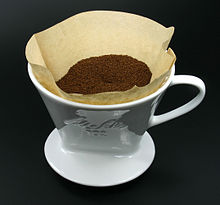coffee filter
A coffee filter is a filter that prevents coffee grounds from getting into the brewed drink when preparing coffee . They are available as permanent filters made of porcelain or metal, as well as disposable filters made of filter paper that is placed in a holder. Coffee that has been prepared using a coffee filter is called filter coffee .
history
Originally, coffee was made by boiling the powder with the water. When serving, the coffee was then decanted or poured through a sieve to hold back the coffee grounds. On the one hand, this method was cumbersome and, on the other hand, the coffee could not be kept for long or boiled again, as more and more bitter substances were released from the powder over time.
In the 18th century, a new method of making coffee emerged that kept the water and powder separated when they were boiled. For this purpose, a filter made of linen or blotting paper was placed in a funnel and filled with coffee grounds. Water poured over it ran through and was collected in a jug, while the powder remained in the filter. Bags made of fabric, known to this day as tea socks or tea stockings, were also used, which were then washed out for repeated use.
A large number of permanent filters emerged, such as the Arndt coffee brewing machines or the Vietnamese Phin filters. These were basically a water container with a perforated bottom that acts as a sieve (see strainer ). At the beginning of the 20th century, pointed funnels were made from metal or porcelain , which also served as a sieve.
In 1908 Melitta Bentz developed a paper filter. In the same year, the Melitta company manufactured disposable filters from filter paper with the appropriate filter holders. Until 1934 they were made of aluminum or enamelled sheet metal. Only then were they replaced by filters made of porcelain or ceramic .
At that time there were also competing products to Melitta , including a so-called Erka filter made of sheet iron with a bottom sieve, the so-called “Bremen coffee pot” with an enamelled sheet metal insert and a sieve, the Burleya filter made of aluminum, an Aha filter with a sieve tube as well as several porcelain filters. The Carlsbad slotted sieve was also known . In the 1930s, Melitta brought the so-called quick filter onto the market, which was curved and grooved so that the coffee could flow through quickly. In 1937 it was available in seven sizes, calculated for one cup up to a maximum of 100 cups of coffee at a time. In the 1950s, other competing products appeared, for example the Maestra filter in the shape of a tea ice cream and a press-shaking filter from Columbus . At the beginning of the 1960s, coffee pots with an integrated filter came onto the market.
Permanent filter
Permanent filters are usually designed as water containers with a perforated bottom. Sometimes they have a lid and a stamp that prevents the powder from being whirled up when the water is poured in.
There are also flexible filters made of metal foil or fine-meshed plastic fabric.
After preparation, they can be cleaned and used over and over again.
Disposable filters
Disposable filters are made of filter paper and are inserted into a filter holder. They are thrown away after a single use. The pores that the network of cellulose fibers form are smaller than 10 µm. You can therefore filter finer ground powder than permanent filters.
Melitta introduced a new numbering for the sizes of the filter bags around 1960 , which has survived to this day. Initially, the numbering 1x2, 1x4, etc. stood for the number of cups of coffee that could be made with the respective filter bag and the corresponding amount of coffee powder. Before you chose to manually brew the coffee in z. B. a porcelain filter the size of the filter bag according to the desired number of coffee cups such as 100, 101, 102, 123 or 103. The filter sizes 100, 101, 102, 1x2, 1x4 and 1x6 are still commercially available as common household sizes.
literature
- Martin Beutelspacher: Techniques of coffee preparation. On the way to optimizing coffee enjoyment . In: Ruth-E. Mohrmann (Ed.): Eating and drinking in the modern age . Waxmann, Münster 2006, ISBN 978-3-8309-1701-4 , pp. 125-146 .
- Coffee (encyclopedia entry 1837). In: Pictures-Conversations-Lexicon for the German people. 1st edition, FA Brockhaus, Leipzig 1837. 1837, accessed on July 2, 2018 ("It is better to put the coffee in a filter sack and pour the boiling water on it").
- Coffee (encyclopedia entry 1857). In: Pierer's Universal Lexicon of the Past and Present. 4th edition, publishing house by HA Pierer , Altenburg 1857–1865. 1865, accessed on July 2, 2018 (“Usually, however, it is filtered before use, but others also prepare it by pouring boiling water over it, ground K. in its canvas”).
Web links
Individual evidence
- ^ Johann Georg Krünitz: Economic Encyclopedia . tape 32 , 1784, pp. 172 ( full text in Google Book Search).
- ↑ a b Heinz-Peter Mielke: Coffee, tea, cocoa. The soaring of the three "warm pleasure drinks" . Museumsverein Dorenburg, Viersen 1988, ISBN 3-924568-02-2 .




